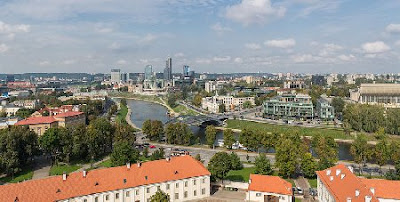 |
| Vilnius |
The Baltic countries of Estonia and Latvia have produced Paul Keres and Mikhail Tahl, but Lithuania is much less appreciated for it's chess history. Semyon Alapin (1856-1923), born in Vilnius is well known, but less well known are players such as Abram Rabinovich (1878-1943) who moved to Moscow during World War Two and Arved Heinrichsen (1879-1900), whom almost nobody remembers. Heinrichsen went to Berlin to study medicine and played in a few local tournaments. His career was cut short when he died in Vilnius at the age of 23 from tuberculosis. Solomon Rosenthal (1890-1955) was born in Vilnius and was also a lesser known master. He won the Belarusian Chess Championship twice.
In 1909 a major tournament was held in Vilnius that was won by Akiba Rubinstein, ahead of Sergei Freiman, Abram Rabinovich, Fyodor Duz-Khotimirsky, Georg Salwe. And, in 1912, the 4th All-Russian Championship was held there. The major section was won Rubinstein followed by Ossip Bernstein, Stepan Levitsky, and Aaron Nimzovich. The minor section was won by Karel Hromedka followed by Efim Bogoljubow.
Lithuania became an independent country in 1918, but in 1940 it was annexed by the Soviet Union and its players were then identified as “Russian.” Probably the most famous Lihuanian player was Vladis Mikenas (1910-1992). Although he was born in Estonia, he moved to Lithuania in 1931. Mikenas played first board in 6 chess Olympiads and won the championship 12 times (1933, 1934, 1935, 1945, 1947, 1948, 1961, 1964, 1965, and 1968).
Ratmir Kholmov (1925-2006) won the Lithuanian Championship ten times (1949, 1950, 1951, 1952, 1953, 1955, 1957, 1958, 1959, and 1960). He was awarded the GM title in 1960.
Another fairly well known Lithuanian was Povilas Vaitonis who tied for first in the 1934 Lithuanian Championship, but lost the playoff to Mikenas. He also tied for first in 1934, 1937, 1938, and 1942. In 1944, he was leading in the Championship tournament when it was interrupted by war. After the war he moved to Canada where he won the Canadian Championship twice. He was inducted in to the Canadian Hall of Fame in 2011.
Another Lithuanian player that pops up in old U.S. chess archives is Morris Shapiro (1903-1996) who won the Manhattan Chess Club Championship in 1921 and 1922.
After World War Two many players from the Baltic countries escaped to the West. Among the Lithuanians were Romanas Arlauskas (1917-2009) who first fled to Germany, but ended up in Australia where he won the Australian Championship in 1949. Also a correspondence player, he finished 3rd in the 4th World Correspondence Championship (1962–1965) and was awarded the Correspondence GM title in 1965.
There are a number of prominent Lithuanian players today: Viktor Gavrikov, Eduardas Rozentalis, Vidmantas Malisauskas, Sarunas Sulskis, Aloyzas Kveinys, Viktorija Cmilyte and Darius Zagorskis.
WGM Camilla Baginskaite of Vilnius won the Lithuanian Women’s Chess Championship at the age of 15, the youngest ever to win a Lithuanian championship in 1982. In 1987, she won the World Junior Championship for Girls. In 1997 she moved to San Francisco and obtained a master's degree in history of art. She married GM Alex Yermolinsky.
In 1984, Lithuanian-born Victor Palciauskas won the 10th World Correspondence Championship. He was inducted in the U.S. Chess Hall of Fame in 1993.
In 1979, three strong tournaments were held in Vilnius. The Vilnius Championship was won by Alexander Ivanov (born in 1956 in Omsk) who eventually moved to the United States where he was joint U.S. Champion in 1995 with Nick de Firmian and Patrick Wolff. There were also two “Zhalgiris” events. Zhalgiris Žalgiris is a translation of the German word Grunwald (green forest) and can refer to a basketball team from Kaunas, a basketball team from Vilnius, a soccer team from Vilnius, a soccer team from Kaunas, a multi-purpose indoor arena in Kaunas, a multi-purpose stadium in Vilnius or a multi-purpose stadium in Klaipeda. Or, I suppose, the chess tournament in 1979.
The Championship tournament was won by Semyon Palatnik. Sam Palatnik was born in Odessa, Ukraine in 1950 and relocated to the United States in the 1990's and along with his friend and co-author, Lev Alburt, he authored popular training manuals and was a successful coach.
The Zhalgris “Open” was actually a 16-player round robin that was won by Edvins Kengis with an undefeated 11 points. Gediminus Rastenis (also undefeated) and Alex Yermolinsky tied for second and third. Yermolinsky suffered two defeats: Rastenis and 8-9th place finisher Aloyzas Kveinys.
Here is an interesting game played in the Championship between third place finisher Vyacheslav Osnos and second place finisher Gintautas Piesina. Osnos (1935-2009) was a Soviet player, trainer and author. He was awarded the IM title in 1965, and was champion of Leningrad in 1971 and 1980. He competed in six Soviet championship finals from 1963 to 1968. Piesina (1953-2014) was an IM who was Champion of Lithuania in 1972 (shared), 1974, 1978 (shared), 1984, and 1988 (shared) and Baltic champion in 1977 and 1988.



No comments:
Post a Comment